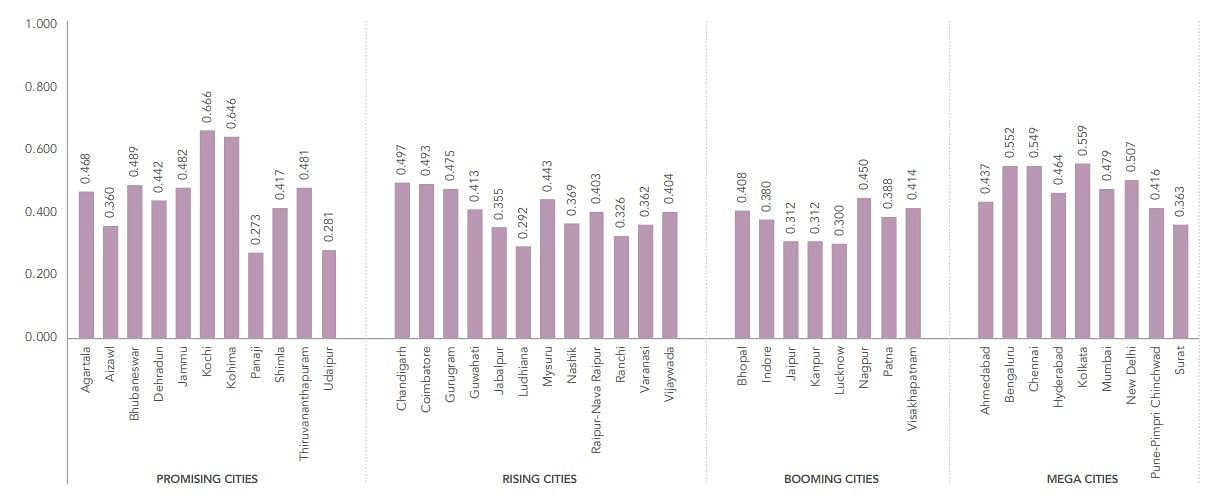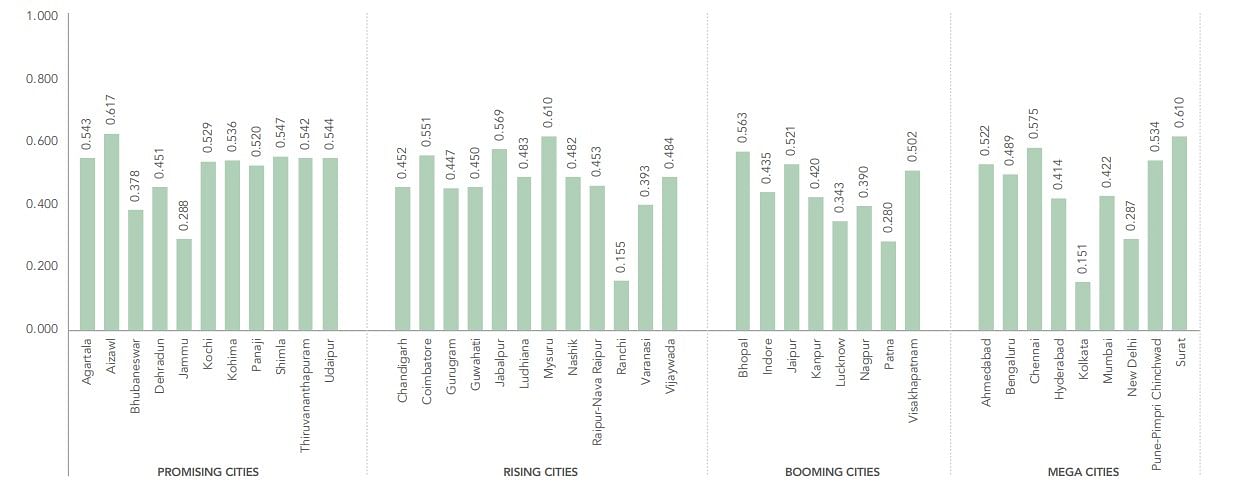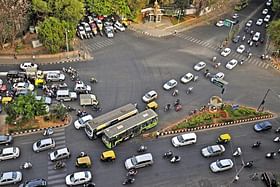The Ease of Moving Index 2022 is a composite index that evaluates 41 indicators based on nine parameters.
Mumbai, the financial capital, has the highest public transport usage, with sufficient availability throughout the city, including at night. Additionally, Mumbai residents were among the lowest monthly spenders on transport.
Cities in India that are projected to have a population of over 40 lakhs have more effective active and shared mobility systems which are more efficient and reliable as compared to the cities with lower population densities.
Additionally, cities with under 10 lakh projected population lead on clean mobility, as per the Ease of Moving Index 2022 (EoMI) India report prepared by the Ola Mobility Institute (OMI).
The EoMI-2022 was launched in Delhi on 25 April by Kunal Kumar, joint secretary and mission director of Smart Cities Mission, and Shombi Sharp, United Nations resident coordinator in India.
As per the report, the Ease of Moving Index is an adaptation of the Human Development Index (HDI) 10 widely used for over 30 years now to assess and compare countries on development indicators.
The report outcomes are based on India’s largest survey incorporating responses from 50,488 survey respondents, 220 focus group discussion participants and data from government and other sources.
The EoMI 2022 is a composite index that evaluates 41 indicators based on nine parameters.
These parameters include — the adoption of active and shared mobility solutions; intermodal connectivity; ease of walking and use of non-motorised transport (NMT) in cities; inclusivity based on gender and functional difficulties; affordability; accessibility to public transport; adoption of cleaner and greener mobility solutions; technology innovations; and financing of mobility infrastructure in various Indian cities.
The selected 40 cities that represent over 25 per cent of India’s urban population are categorised based on population density.

Indications From The Report
According to the report’s findings, Kolkata has the highest number of buses per lakh population, making it the leader in active and shared mobility adoption among “Mega Cities”.
Mumbai, the financial capital, has the highest public transport usage, with sufficient availability throughout the city, including at night. Additionally, Mumbai residents were among the lowest monthly spenders on transport.
A shared and active mobility system is influenced by a robust and modern public transport system catering to the needs of all commuters.
Additionally, the functioning has to be complemented with seamless first and last-mile connectivity through walking and cycling (Active Mobility).
It can be measured based on the data for personal mobility, the services and adoption of mass transit and public transport systems in the urban centres.
Kolkata and Mumbai also have the highest bicycle ownership rates in this category, with Pune-Pimpri Chinchwad following closely behind. Kochi, on the other hand, has the most potential for adopting active and shared mobility solutions.

Further, Pune tops with the having the most inclusive mobility systems, while Nagpur has the most efficient and reliable public transport system.
Mobility for All can be assessed by evaluating transport systems that are accessible and cater to the requirements of diverse population groups. Furthermore, Ludhiana has the highest percentage of public transport usage among women and trans/non-binary individuals.
Ludhiana stood with the highest percentage of public transport usage among women and the trans/ non-binary.
Cleaner and sustainable modes of transportation has become a top priority for nations worldwide. While India has made a sincere effort to adopt electric mobility, establishing a long-term vision with a sustainability focus will shape the future of mobility.
The report indicates Aizawl, Mizoram stood highest on clean mobility, whereas Ahmedabad, Gujarat has the highest willingness to adopt electric vehicles.
Further, Mysuru, scores the highest in clean mobility parameters in its cluster owing to better air quality and lower air pollution-related deaths per lakh population. It also has the cleanest and most hygienic public transport infrastructure as perceived by public transport users.

In terms of use of walking and cycling infrastructure, Agartala, Tripura has the best walking infrastructure.
Additionally, most people walk and cycle to access public transport in Jammu while almost everyone in Kohima, Nagaland owns a bicycle.
Chennai has been identified among the cities to have the best and cycling infrastructure in India.
The EoMI-2022 is the second edition of the index, following the first edition that was released in 2018.
The initial edition evaluated 50 indicators classified into three pillars: People, Infrastructure, and Sustainability.
The 2018-EoMI analysed secondary data obtained from authorities and primary data gathered from approximately 43,500 respondents across 20 cities.
The current report also includes a comparison of citizens’ reported mobility patterns and perceptions between 2018 and 2022.
According to the comparative analysis, out of the 18 cities covered in both editions, nine cities have experienced an increase in public transport usage.
Furthermore, the comfort level perception has improved in 15 cities since 2018. The report also revealed that 12 cities have received higher cleanliness ratings this year, suggesting an improvement in the public transport users’ perception of its cleanliness.


